Episode 163
What you’ll learn in this episode:
- Why every art student should have business classes as part of their curriculum
- How the American mythology of the starving artist is more harmful than helpful
- Why it’s important to expand a creative business beyond just making
- How polymer clay went from craft supply to respected artistic medium
- Tips for entering jewelry and art exhibitions
About John Rose and Corliss Rose
2Roses is a collaboration of t Corliss Rose and John Lemieux Rose.
The studio, located in Southern California, is focused on producing one-of-a-kind and limited-edition adornment and objects d’art, and is well known for its use of a wide range of highly unorthodox materials.
The studio output is eclectic by design and often blended with an irreverent sense of humor. 2Roses designs are sold in 42 countries worldwide and are exhibited in major art institutions in the US, Europe, and China.
Photos:
Heart Brooch
Attending the Yuma Symposium caused this brooch. It is a “thing” at Yuma to do a second hand store crawl. There are many located all over the city, and well stocked because of the annual snow-bird influx. It has become kind of a game at the symposium to see who can scoop the best and weirdest deals. One year we stumbled into a shop that was unloading a huge inventory of “junk” jewelry by the kilo. We bought it all and promptly deconstructed the cache for parts. We were instantly in possession of more beads of every imaginable size, color, and shape than we would ever use in our lifetime. This brooch is the result of having more beads than you know what to do with…and because everybody likes hearts.
Beads, resin, sterling silver.
4 inch H
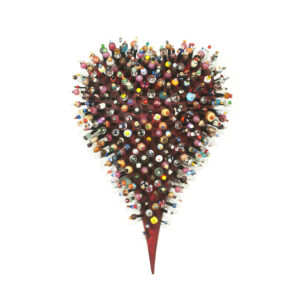
We Ran Off and Joined the Circus Bracelet
Art Jewelry is often about a narrative. This bracelet is part of a series that we created to express our real-life experiences. In this instance, we really did run off and join a circus at one point in our lives. It was every bit as strange and exotic as you might imagine.
Polymer clay, sterling silver
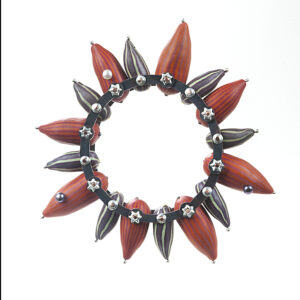
Mojave Bouquet Brooch
We spend considerable time in the deserts of the American Southwest and Northern Mexico. Pieces that interpret that landscape have been a recurring theme throughout our careers.
Corlite, sterling silver
3 inch H
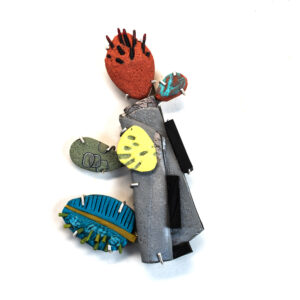
HiTek Mosaic Necklace
As technology entrepreneurs, we have deep connections with many industrial sectors. This has afforded us access to a mind-boggling array of odd materials that have crept into our jewelry. Our HiTech series exposes the beauty hidden in the technology that we are literally surrounded by, but often never see.
Electronic components, 18kt gold, sterling silver
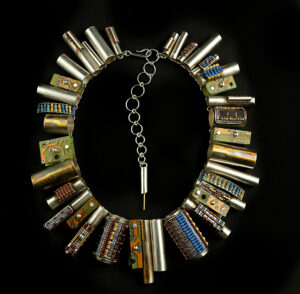
Big Green Brooch
This is another in the series of objects that express our direct real-life experiences. This brooch is related to Corliss’s growing up in a floral shop and designing corsages from an early age.
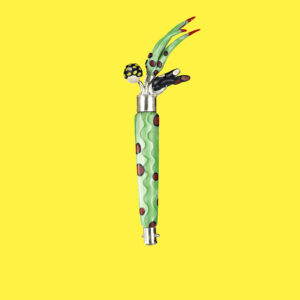
Additional Resources:
Transcript:
For John and Corliss Rose, business and artistic expression don’t have to be in conflict. Entering the art world through apprenticeships, they learned early on that with a little business sense, they didn’t need to be starving artists. Now as the collaborators behind the design studio 2Roses (one of several creative businesses they share), John and Corliss produce one-of-a-kind art jewelry made of polymer clay, computer chips, and other odd material. They joined the Jewelry Journey Podcast to talk about their efforts to get business classes included in art school curriculum; why polymer clay jewelry has grown in popularity; and how they balance business with their artistic vision. Read the episode transcript here.
Sharon: Hello, everyone. Welcome to the Jewelry Journey Podcast. This is the second part of a two-part episode. Today, my guests are designers John and Corliss of the eclectic design firm 2Roses. Located in Southern California, they sell worldwide. 2Roses in an award-winning design recognized for their use of unusual materials. Welcome back.
When you look at these things, do you have visions right away? Does something jump out at you that says, “Oh, there’s a pair of earrings,” or “There’s a pendant. I can do something with this”?
John: Sometimes.
Corliss: Sometimes. With the way I personally work, I have a table full of all sorts of things. I’ll take a certain amount of time and just look and pick and group and put this away. It’s almost like a cat playing with a couple of little toys. You put it over here and you scoot it over there. Then we’ll have dialogue about it, and we’ll talk about things. Then it’ll rest, and it’ll come back. Sometimes the decision is immediate; sometimes it takes a little while. It’s just the process. It’s the same thing when John works. He’s a little more direct than I am. I’ve learned from a couple of other peers that it’s very helpful to have many, many things at the table at the time, because you can look at a variety of things and the mind just flows. It’s like automatic writing. But John’s very direct. He’ll go through a process and then say, “Come here. Let’s talk about this,” and we’ll talk about something.
Sharon: What’s the division of responsibility between the two of you? Does one person do the back-office stuff and the other person makes? Do both of you do the creative aspect? How does that work?
John: We’re very collaborative. It’s a very fluid process. I always refer it to as improvisational jewelry design. We don’t set out with a plan to make a series of things, although themes and series have evolved organically through the process. We see these themes—moral themes, humor, political or social statements—just keep cropping up on their own to our particular point of view. But within the jewelry production design, it’s really—
Corliss: It’s fluid. Depending on the task that needs to be done, some things I will be better at soldering. There are some things that John does. He does a lot of—
John: Welding.
Corliss: Machinery and welding and things of that sort, engraving. That’s where things maybe get a little compartmentalized. Not in the creative thinking process, but in the actual, physical production stages. “O.K., I’ll take this stage. You do that better, so you do that and we’ll talk about it.” That’s what happens.
John: We don’t want to get too far away from our business sides, like, “O.K., who’s more efficient for the task?” But we do have certain divisions of tasks. On the back end, when it comes to the hard business stuff, Corliss tends to be the accountant. I’m the sales and marketing guy. She does all the web work. I do social media. I’ll do photography and she’ll do inventory. We do have certain tasks we fall into, but it tends to be more business operations than the creative work or production.
Sharon: Interesting. How many other businesses do you have? John, you have a multi-media empire it seems. What do you have here?
John: The main corporation is called Mindsparq. That’s really an umbrella corporation. Underneath that, we have a variety of different business entities. There’s the marketing company. There’s 2Roses Jewelry. We have an education arm, a publishing arm, photography. I do a lot of restoration work.
Sharon: Restoration? I’m sorry, I didn’t hear that.
John: Of jewelry antiquities.
Sharon: Oh, really. Interesting, O.K.
John: We’re working with a lot of museums, auction houses, things like that, movie studios. That’s turned into a whole thing unto itself. Then we do light manufacturing. There are a lot of different business entities. Some are intertwined with the jewelry; some are not.
Sharon: Corliss, you’re doing the teaching on the educational videos or the educational aspect. How does that work?
Corliss: Yes, a lot more video now. I found that Zoom has opened up a whole wonderful world for expanding education, where I used to have to rely on being someplace in person, and the students had to rely on airfare, hotel rooms, that sort of thing. I have a very international following with online instruction in all different variants. It has proven to be not only lucrative, but very rewarding personally. John has been very instrumental in helping get the lighting and the connectivity set up and teaching me about different cameras and how to adjust them while I’m doing my instruction, that sort of thing. It’s worked out very well.
John: I keep her on her marks.
Corliss: Oh, yes.
Sharon: It’s so meticulous when you’re trying to demonstrate something like jewelry making, metalsmithing, how to weld something, how to incorporate metal into this or that, because you’re so close. It’s like a cooking class in a sense. How do you show how to do it?
John: Yeah. Actually, the things we were doing with cooking demonstrations when Corliss was more involved in that helped us a lot when we started doing jewelry demonstrations and workshops. Basically, the videography and the whole setup is very, very similar.
Sharon: So, you were ready when Covid came around. When everybody was on lockdown, you were already up and running.
John: We were.
Corliss: Yeah.
John: Actually, what you’re seeing behind us, we’re in our broadcast studio now.
Corliss: With some of the equipment behind us.
John: Yeah, when Covid hit, we made the investment to set up a complete streaming broadcast studio because it was obvious that this was going to be the transitional network. It wasn’t going to just be for the next six months.
Corliss: We’ve always been very pragmatic about trends and where everything is going. During the pandemic, we saw Zoom as something that was going to outlast the pandemic. It was going to cause a shift in education and a lot of other things, business meetings. So, we took the time to invest in learning the software and watching all the how-to videos and getting questions answered. We wanted to be able to hit the ground running with a certain amount of knowledge and have things work correctly, have that person’s first impression be a good one, whether it was a student or I was doing a board meeting or whatever. We just saw that as the right thing to do.
Sharon: Do you see trends both with jewelry and with this? Zoom will continue, but do you see more polymer clay? Maybe it’s me. It seems to have subsided. Maybe it was a big thing when it came out. I heard more about it, and now it’s—not run of the mill; that’s too much—but it’s more widespread, so people aren’t talking about it as much. What are your thoughts about that?
Corliss: You’re talking about the polymer clay, correct?
Sharon: Yes.
Corliss: There have been advancements made within the community, but I actually see the most innovative work coming out of Eastern Europe. There’s a design aesthetic there that is very traditional and very guild-oriented. There’s a different appreciation of fine art over there, where in America this is a craft media; it’s something to introduce young children to. There’s nothing wrong with that at all, but it’s just a different perspective on it.
John: I was just going to add that what you see in Europe is more professional artists.
Corliss: Yes.
John: Mature, professional studio practices incorporating very sophisticated raw material. Right now, the more innovative stuff is coming out of Europe. How that plays out, that’s not to say there’s nobody in America. I mean, obviously there are.
Corliss: There’s more happening now. We’re seeing more and more of our contemporaries getting into the large exhibitions, the large shows with very wonderful work. It’s very satisfying to see that, but it’s been a slow growth, mainly because this particular medium was introduced as something crafty and not something to really be explored as an art form. That came from within when polymer clay was first manufactured from a very small group of people who saw the potential of it. They set the foundation of pursuing polymer clay as an art form. It’s taken a while to grow, but it is starting to get a little bit sweet now.
John: And that’s not really different from other mediums. Look at it: it’s just a medium. If you look at the introduction of acrylic paints into the painting world, it took 75 years for those to eclipse other things. Polymers are on that path.
Corliss: They were first invented, I think, in the 70s and 80s as a—
John: Well, they were invented of course.
Corliss: Yes, that is absolutely correct, but as an art supply. They were made in the 1980s. That’s when they started being discovered.
John: Do you know how polymer clay was invented? Do you know the story?
Sharon: No.
John: It was invented by the Nazis.
Sharon: Was it? For what?
John: During World War II, for the leadup to World War II, it was an industrial material that was invented as a substitute for hard-to-find steel and things like that. It was used in manufacturing leading up to the war. It’s an incredibly versatile and really durable product, and it’s very plastic. It can be used for a lot of different things. So consequently, it was sitting on the shelf for many years, many decades, until around the 1980s when somebody somewhere discovered this stuff and said, “Hey, look at this. We can throw some color into it and do all sorts of crazy, artistic stuff with it.” That’s where it took off.
Corliss: That was the start of Premo, and now you have countless brands of polymer clay that are being manufactured. Just about every country on earth has its own brand of polymer clay, including Russia and Japan. Polymer clay is very big in Japan.
Sharon: That’s interesting.
John: Including us. We have it as well.
Sharon: You are early adopters, then. It sounds like very early adopters.
Corliss: Back in that particular time, the internet was just getting started. There wasn’t a big outlet like there is today with social media for polymer clay enthusiasts or groups or fellow artists to get together. I learned everything online. There were one or two websites that acted as portals with links to different tutorials and other web pages with information about products, manufacturers’ pages, that sort of thing. I learned polymer clay online.
Sharon: Wow, online.
John: There were no instructions.
Corliss: No, there was nothing.
Sharon: Wow! I give you a lot of credit, the stick-to-itiveness and determination to say, “I’m going to learn this.” Polymer clay, I took a class decades ago where they used some—is it baked?
Corliss: Yes, we prefer to call it cured.
Sharon: Cured, O.K.
Corliss: And some of the terminology that’s been developed recently is to give a little more sophistication to the product so it isn’t so crafty. So yes, it’s cured. Most of it is cured around 275º Fahrenheit. There are brands that are cured a little bit higher and maybe slightly lower, but a lot of the brands are interchangeable, intermixable. You can have polymer clay look like a gemstone. You can have it look like old, weathered wood. It’s very adaptable. It’s a perfect mimic. It supplants the use of other materials in different jewelry compositions. It’s a very interesting material to work with.
Sharon: It sounds like it.
Corliss: You can paint it. You can rough it up. You can use alcohol on it, just about anything.
Sharon: Recently you mentioned competition. You enter your work into competitions—I call them competitions. I don’t know what you call them, where they give an award for best—
John: Yeah, exhibitions. That’s something we do. It’s part of the promotion of your work. It’s about getting your name and your work out there in front of as large an audience as possible. It’s one way to approach it. We’ve used that in a lot of cases, and these things are building blocks to how you build a sustainable practice. Being in an exhibition—for example, we’ve been in the Beijing Biennial for three years running. We’ve won numerous prizes for that, and we’re representing the United States. We’re one of six artists that have been chosen to represent the U.S. and one of the only clay artists outside the U.K. That’ll pick up a lot of opportunities for us and allow us to make connections in China, particularly within the arts community in China. Just that one event has caromed off into, I don’t how many years now it’s been playing out, and it has continued to provide opportunities for us to do different things. So, yeah, they can be very, very useful, but you have to also recognize that the opportunities are there only if you recognize them and then take action.
Sharon: Would you recommend it to people in earlier stages of their careers, just for validation, to be able to say, “I won this”? Or would you say don’t do it until you’re ready? What’s your advice?
John: I don’t think we advocate one way or another. All I can speak to is this is what works for us. Results can vary. It depends on how you approach it. We had a discussion about this in one of the arts groups recently, and I was surprised that one of themes that emerged out of that was a lot of artists’ discomfort with competition. If that’s the case, then that’s probably not going to be good advice for you. When you do exhibitions and competitions, you’d better have a thick skin because you need to be able to say, “It’s not personal; they didn’t like my jewelry.”
Corliss: I think one area where we have been a bit instrumental is with younger people who want to enter that first competition for the first time. It’s more of an instructional thing. The technology no longer does slides; you do images. It’s little things like making sure your images all have pretty much the same backdrop, that they’re easy for the jury to look at. Out of the 12 or 15 things that we made, we pick the five or three strongest that we feel would be looked at in front of the jury. When you fill out your questionnaire, if it’s anything you have to hand write, please print legibly. It’s surprising how careless people can be. Just things like that. Don’t be disappointed if you don’t get in. You go through the experience of having a binder three inches thick of, “Thank you very much, but no thank you,” before someone comes in saying, “Congratulations.” Then that new little binder starts growing and growing and growing. It’s more of a basic instruction, hand-holding, a little bit of counseling and, “Here, go on your way. Just give it a try.”
John: For a long time, we confronted ourselves with that kind of thing. We have what we call the “wall of shame.” We post all our rejection letters and say, “O.K., we really suck. Look at this is a massive array of rejection letters.” But I think most professional artists that do exhibitions and things will tell you it’s a numbers game. You just keep submitting and eventually you’ll get into some, and you won’t get into others; that’s all there is to it.
Sharon: Yeah, I can see how thick skin comes in handy.
Corliss: I was just going to say I run to the bathroom and cry.
Sharon: No, but you have to have thick skin to do what you do in terms of putting your work out there. You see people looking at it. They walk to the next table. They walk to the next booth. I was talking to a jeweler about this the other day. It’s challenging right there.
Corliss: I go back again to the early days of the apprenticeship. Speaking for myself, I had some hard masters. I remember one class—I will never forget this guy, Salvatore Solomon. He was a fabulous artist, a very good, well-respected artist, and I’m in class and he comes around. He didn’t say a word, just took the piece I was working on, ripped it up. He said, “Start over.” Oh no, that didn’t sit well with me, but that was his technique. He was very hard on his students, but he was teaching you a number of things. One, thick skin. Two, perseverance. The experience I came out of that with has benefitted me for the rest of my life. Now, I understand what he was trying to do.
Sharon: That would be hard thing to go through. John and Corliss, thank you so much for taking the time to talk with us today. I give you a lot of credit for everything you’ve built, not just the jewelry, but everything around it. Thank you so much for taking the time.
John: Sharon, thank you very much for the opportunity and for taking the time to do this. It’s been a real honor and a pleasure.
Corliss: Yes, it’s been nice. Thank you so much.
Thank you again for listening. Please leave us a rating and review so we can help others start their own jewelry journey.

